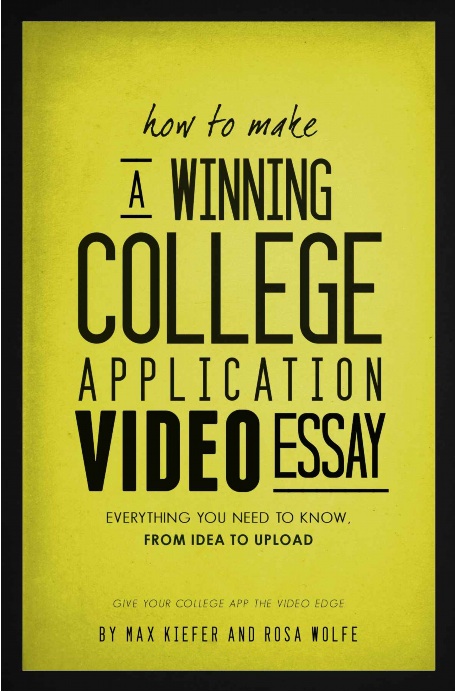Today, I’m reviewing a book entitled “How to Make a Winning College Application Video Essay” by Max Kiefer and Rosa Wolfe. This book is written by parents for students: “We are a husband and wife writing and filmmaking team who have worked together so long that finishing each other’s written sentences is literally our stock in trade.”
In the beginning text in the book, they talk about the emergence of the video college application essay:
UTube officially arrived in 2009 when Tufts University invited applicants to submit an optional one-minute video. Tufts’ director of admissions, Lee Coffin, made this decision after being so impressed with a student video he famously remarked, “I thought, ‘If this kid applied to Tufts, I’d admit him in a minute, without anything else.’ ” With or without Tuft’s paradigm-changing decision, in the Internet age the college admissions video was inevitable. For a generation that has grown up swimming in social media, for whom images are a critical adjunct to communication, it’s hard to imagine that videos would not eventually become an element in the college sweepstakes. George Mason University, William and Mary, and St. Mary’s College have also begun inviting video submissions. More schools will surely follow. In any case, providing the colleges to which you apply with a DVD or a link to a short video essay won’t hurt. You don’t need to ask permission. If a college doesn’t want to look at your video, they simply won’t… but there’s every chance they will.
The bulk of the book provides you with multiple examples (with links) of video admissions essays along with descriptions and critique of each and the type of essay they are. Here are just a few:
http://www.youtube.com/watch?v=pahEF3mdcSY Or google “Tufts: 6 Things You Should Know About Me That My Application Won’t Tell You.”
http://www.youtube.com/watch?v=u-v1uW0oJ40 Or google “Jada Marie GMU Video Essay”
http://www.youtube.com/watch?v=vKOaGKdsIa8 Or google “Harvard University Rejected Commercial”
After providing the reader with examples, the authors then explain the technical details of filming a video, answer some often asked questions, and discuss the planning and shooting aspect of the video. Then they top it off discussing which equipment to use, lighting, sound and finally editing. Once the video is complete, you’ll need to know how to save it, burn it, and upload it. They give step by step advice on how to do this.
In short, your student becomes a filmmaker, telling his/her story to admissions officials. The authors explain it like this:
In a sense, the video is the interview 2.0. While not live face-to-face, it’s still your face in their face. On your terms. Instead of a sweaty-palmed chat where you risk getting a question you can’t answer or having an attack of “ums” and “uhs,” with a video you, as writer and director, control every moment.
Not all colleges require and/or accept video application essays, as the authors point out:
Right now the video is strictly an option. It’s a freebie. Most students applying to college next year won’t be uploading videos to YouTube. Which gives you an edge. So, no, you don’t have to, but if you can find the time and inspiration, making a video essay will give your voice one more chance to be heard in the admissions cacophony.
Do I recommend this book? ABSOLUTELY. In today’s competitive application process, anything your student can use to set themselves apart from the competition is worth the investment.
You can read more about the book at http://collegeapplicationvideo.com/ and purchase it on Amazon for the Kindle (you can download a free Kindle reader for Mac or PC) for a very reasonable price of $7.99.
_____________
All quotes are from the book: How to Make a Winning College Application Video Essay: Everything You Need to Know from Idea to Upload by Kiefer, Max; Wolfe, Rosa (2013-03-18). (Kindle Locations 154-156). Isthmus Press. Kindle Edition.


One thought on “How to Make a Winning College Application Video Essay”
Comments are closed.